Adjustment
The Adjustment Tab contains options for gaining enhanced control of a selected figure or to make path related changes to a figure. The tab will appear as shown below when selected in the sidebar.
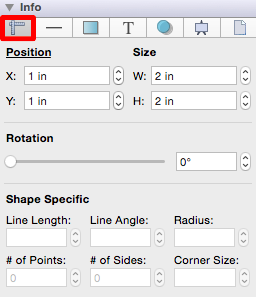
The Position Header located in the upper right corner can be toggled from Position to Center. The Center Header sets the center point of a selected shape or group of shapes. Click on the position header to toggle to the center header options, which appear as shown below:
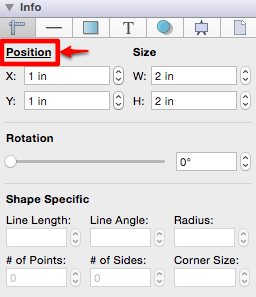
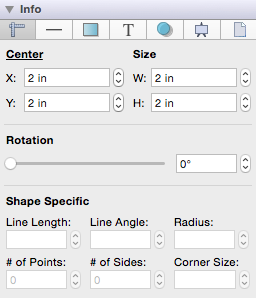
Values displayed in the Adjustment Tab default to Inches or Degrees; however, alternative units of measurement (i.e. centimeters, meters, feet, yards, etc.) or radians rather than degrees may be typed in. These values will be automatically converted to their equivelent in Inches or Degrees.
For example, if 10 centimeters (10 cm) is entered for the Width of a selected figure, then it will be converted to Inches after pressing the Enter Key on your keyboard or selecting another item within the application.
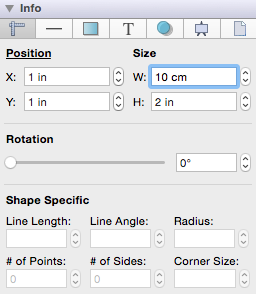
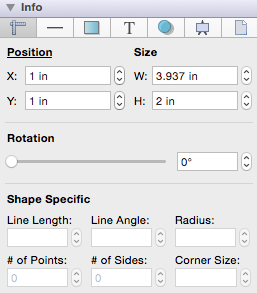
If 100 millimeters (mm) is entered for the Width of a selected figure, then it will be converted to 3.937 inches.
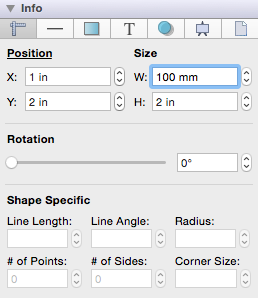
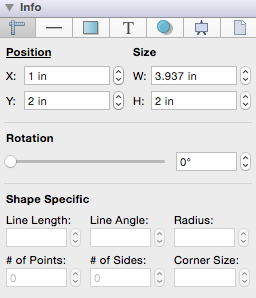
Conversion can also be used for angle measurments that use Degrees (°) as the unit of measurement. For example, if you enter 1 radian (rad) as the Line Angle, it will be converted to 57.296°.
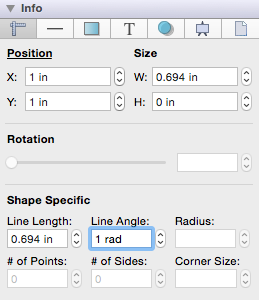
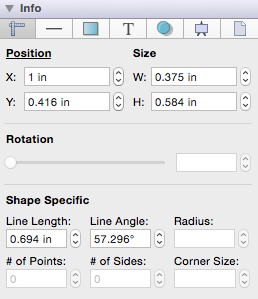
Click on the corresponding Adjustment Attribute name to learn more about what the option does.
| Attribute Name | Description |
|---|---|
| X | The X attribute can be used to set the X position of the currently selected figure to the entered value. It functions as a nudge tool when multiple figures are selected by moving all figures in a manner relative to the entered change. |
| Y | The Y attribute can be used to set the Y position of the currently selected figure to the entered value. It functions as a nudge tool when multiple figures are selected by moving all figures in a manner relative to the entered change. |
| W | The W (width) attribute can be used to set the width of all currently selected figures to the entered value. The width of all figures is set to this value when multiple items are selected. To scale the width based on the relative size within the selected figures, group all of the figures and then resize. |
| H | The H (height) attribute can be used to set the height of the currently selected figure to the entered value. The height of all figures is set to this value when multiple items are selected. To scale the width based on the relative size within the selected figures, group all of the figures and then resize. |
| Rotation | The Rotation attribute can be used to set the angle of the currently selected figure to the chosen slider or keyboard entered value. In the instance of a multiple figure selection, this option will set the angle of all selected figures to the entered value and rotate them relative to their own centers. It is best to group all desired figures and then rotate them as a group when wanting to make this change relative to the center of the selection. |
| Line Length | The Line Length attribute can be used to set the length of a selected line(s). A line must be selected for this option to be enabled. |
| Line Angle | The Line Angle attribute can be used to set the rotation angle of a selected line(s). A line must be selected for this option to be enabled. |
| Radius | The Radius attribute can be used to set the radius of the currently select circle to the entered value. In the instance of multiple figure selection, this option will set the radius of all selected figures to the entered value. |
| # of Points | The # of Points attribute can be used to set the number of points for a star. In the instance of multiple figure selection, this option will set the number of points of all selected figures to the entered value. |
| # of Sides | The # of Sides attribute can be used to set the number of sides for a polygon. In the instance of a multiple figure selection, this option will set the number of sides of all selected figures to the entered value. |
| Corner Size | The Corner Size attribute can be used to set the size of the corner for a rounded rectangle. The units for the corner size are the units of measure of the drawing. For example, if the units of measure for the drawing were inches and the size of the corner is set to “.25”, the corner size is 1/4 of an inch. |
Note: The value displayed in the text field of each attribute setting represents the value of the first selected figure.